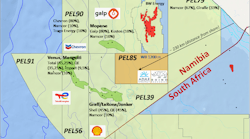The US Bureau of Land Management quietly moved toward better relations with surface landholders in July as some of its state offices issued notices that those landholders' names and addresses will be required in expressions of interest (EOI) for future lease sales involving split estates.
"Once BLM gets the names and addresses from the party submitting the EOI, we intend to notify the surface owner of this, and send them a notice if the tract goes up for lease," said Robyn Shoop, the agency's acting senior mineral leasing specialist.
This will occur before the land goes up for lease and give all parties a chance to look at parcels and provide input, Shoop told OGJ on Sept. 4. "It's a courtesy on our part because the mineral estate is dominant, but it brings surface owners into the picture sooner," she said.
The notification's time frame could vary because each state office prepares its lease sales differently, Shoop said. The agency has asked each state office to issue two consecutive monthly oil and gas lease notices with this requirement stated, she said.
Roots in EPACT
The initiative started under the 2005 Energy Policy Act, which directed BLM to review its policies involving subsurface leases and surface owners, Shoop explained.
"After meeting with private surface owners, we concluded that they would like to be contacted sooner when BLM is leasing minerals underlying their property. Two state offices already had such a program, but we wanted to make sure it was consistent bureau-wide," she said.
Shoop said some smaller producers say the requirement could be an added burden because they may have to retrieve the name and address from paper tax records at a county courthouse. But the information in other states and counties is readily accessible online, she said.
"Surface owners appreciate this. It promotes better interaction between the subsurface lessee, the surface owner, and the BLM in the long run," Shoop said.
West Virginia concerns
Surface landholders in West Virginia, where split estates primarily involve private entities, also would like to be involved sooner, noted David McMahon, cofounder of the West Virginia Surface Rights Owners' Association. "The only notice a surface landowner gets now is when someone who wants to drill goes to get a permit from the state," he told OGJ.
McMahon conceded that many producers contact surface owners before coming onto the land, but added a requirement to do so earlier could accommodate surface uses before soil erosion, sediment control, and water protection studies are conducted. "Wells can be moved easily here because these are stratigraphic instead of structural traps," he said.
As it is, he said, the state requires a subsurface lessee to send a copy of the drilling permit application to the surface owner, who has 15 days to comment and no right to a hearing or appeal. "Surface owners feel they should have more than that," he said.
